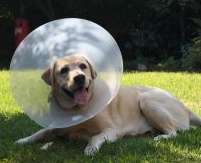Recognizing Conjunctivitis In Dogs
While conjunctivitis in dogs is generally an easily treated minor condition, the symptoms can alsobe signs of more serious dog eye problems.
What is Conjunctivitis In Dogs?
Canine conjunctivitis, also known as pink eye, is a very common eye problem in dogs. Basically it is an irritation or inflammation affecting the mucus membrane that lines the inner surface of the eyelid and white part of the eyeball - extending to the cornea.

This membrane is important in protecting the eye from microbes as well as providing a portion of the moisture needed for eye health.
Conjunctivitis is a sign that something is interfering with the functioning of this membrane. Sometimes the interference may extend to the white of the eye, producing the appearance of a "pink eye".
Symptoms of Conjunctivitis In Pets
One of the first symptoms a pet owner will often notice is that his dog is rubbing his paw against the affected eye
or eyes - an indication that the dog is experiencing some irritation. If this symptom escalates, the
condition affecting the eyes is more significant, making them either itchy, dry, and/or painful.
Other signs to look for:
- The eyes appear red and swollen, to a lesser or greater degree.
- A discharge may be present around the eyes.
- The discharge has the appearance of mucous, is pus-like, or is just watery.
- Eyes may stick together when closed.
- Eyes may appear weepy.
- The dog may be squinting of shutting his eyes, especially around bright light.
- The dog may seem tired?
Treatment of Conjunctivitis
Finding the underlying cause of conjunctivitis in dogs is the first step in
determining the appropriate treatment. Some aspects of this condition
can be handled at home, but beware....
There are some serious eye problems that have symptoms similar to those
seen in conjunctivitis.
One is Keratitis, or inflammation of the cornea. If a dog's eyes are red and teary with accompanying blinking or squinting and he favors keeping his eye shut, he could have this condition which can very quickly lead to ulceration of the cornea - and even loss of sight.
Scratches or embedded objects involving the
cornea can also lead to this condition, as can untreated dry eye.
What's important to remember is there's no time to waste. Immediate attention
of a veterinarian is needed if these signs are present. Two eye
conditions that may be similarly indicated, are glaucoma and uveitis.
Many times conjunctivitis is one of the milder types such as those caused by environmental allergies where the eye tissue looks a bit red and has a clear watery discharge.
The first line of defense in this case, is frequent flushing of the eye throughout the day with a natural eye wash. Also, if any discharge has crusted around the rim of the eye, take a cloth soaked in warm water and gently compress it to the area to for a few minutes to loosen the material so that you can wipe it away.
If the eyes continue to discharge, it may be an infection requiring a vet's diagnosis.
Foreign Object in the Dog's Eye?
When you can see that a foreign object is embedded in the cornea, do not try to remove it.
While eye flushing may be able to release the
object, since the cornea is critical to vision, the wisest course of
action is to take your dog to the vet for expert removal.
Follicular Conjunctivitis
When treating follicular conjunctivitis, an allergic condition that
affects the immune cells in the conjunctiva of the eye with resulting irritation, your vet may recommend antibiotic
ointments if an infection has been
identified as the root cause.
The same is true for other types of conjunctivitis that have escalated into bacterial conditions.
E-Collar Protection
Whenever your pet is showing repeated signs of an eye problem, such as frequently rubbing at his eye, attaching an e-collar is a good idea for the sake of eye protection until the cause is determined.
It's also helpful during treatment.

Causes of Conjunctivitis
Allergies are a common cause of conjunctivitis in dogs. The allergen may be of the type carried through the air such as dust and pollen. It could be a food related allergy or another culprit could be an insect bite.
- Foreign objects: Is your dog the type that likes to run through the brush when out on a walk, or has been known to hang his head out the car window on a ride? - (not recommended by the way). If so, he may have paid a high price for his fun by getting some debris or plant matter such as thorns or seeds embedded in his eye. Even the wind itself can have a damaging effect!
- Infection based - either viral or bacterial conjunctivitis. This type is often the result of a mild condition that becomes infected through the build-up of bacteria. It can also be the result of a "dog-to-dog" contagious viral infection.
- Do you have a scrappy dog that doesn't walk away from a confrontation? Could he have received a scratch to the eye during such an encounter. Eye damage involving the cornea can be a trigger for conjunctivitis.
- In the presence of an irritant, the conjunctiva, may swell and form a rough surface. Even after the irritating condition is resolved, the roughness on the membrane may remain, resulting in a continuous irritation and associated mucus discharge. This condition is termed follicular conjunctivitis (discussed above).
Although eye problems, such as conjunctivitis in dogs, can and does affect many breeds, those with prominent eyes are more at risk for eye diseases and damage.
Among them, to name just a few, are Shih Tzus,
Cocker Spaniels, Lhasa Apsos, Schnauzers and Bulldogs.
Prevention of Conjunctivitis In Dogs
Usually the best form of prevention has its roots in hygiene and sound
nutrition - (much the same advice given by your dentist to protect your
teeth!).
That being said, the preventative steps include:
- Providing a high quality diet for your dog that includes supplemental anti-oxidants such as Ocu-Glo For Vision and using an eye cleaning solution as needed, such as this one Vetericyn Canine Eye Wash.
- Conducting an inspection of his eyes every week and keeping them clean and well-groomed. Trimming any hair follicles that may pose a threat to the eyeball.
- Scheduling regular eye exams by a professional.
The advantage of having a preventative plan in place is that eye
problems will be identified and treated promptly, ensuring the best
chance of a successful outcome for your pet.
Conjunctivitis in dogs is not something to be ignored because it involves a pet's window to the world - his most precious eyes.
Don't take chances.
More about dog eye diseases at avco.org
Other Health Related Topics

